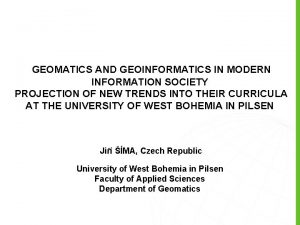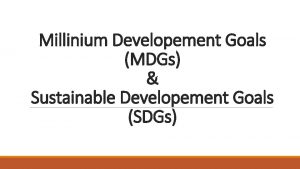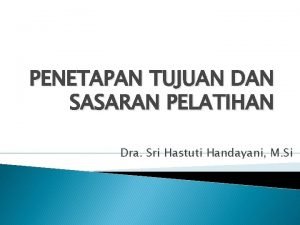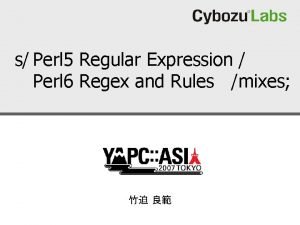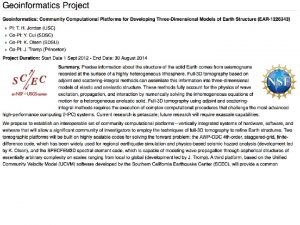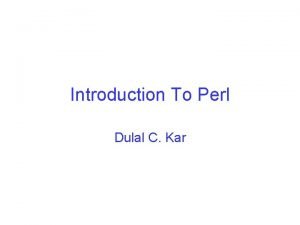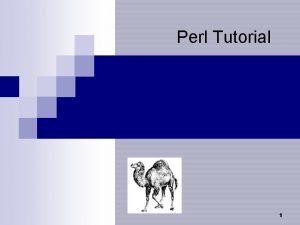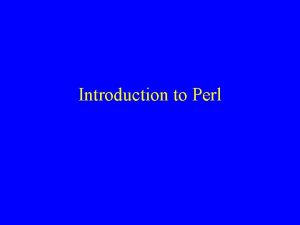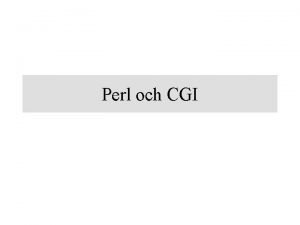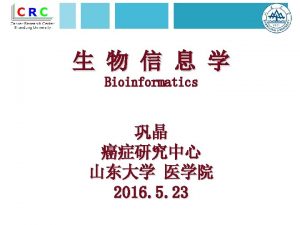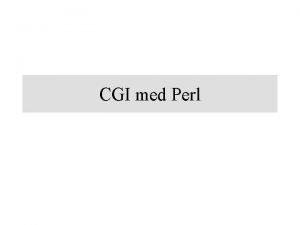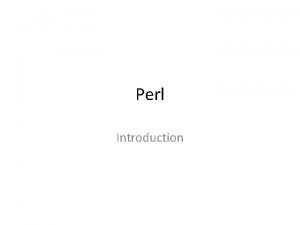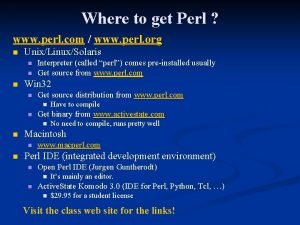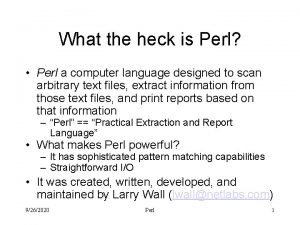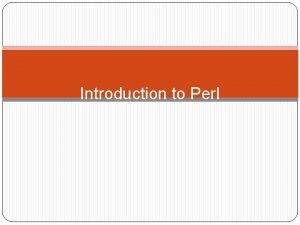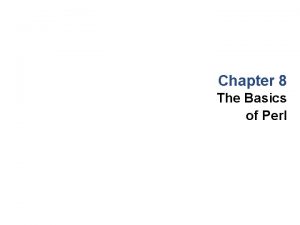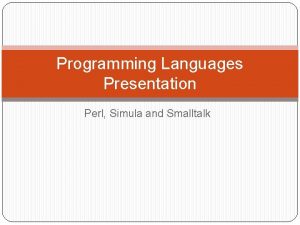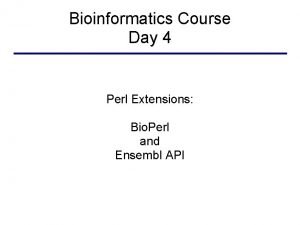Geoinformatics tools with Perl integration development needs Goal



















- Slides: 19

Geoinformatics tools with Perl: integration, development, needs • Goal: a programmable environment for geoinformatics – data management, integration, analysis – handle large and voluminous; complex and mixed format data sets – program tools for web and GUI and CLI desktop

Use cases / requirements • An analysis / data processing tool which is used 1. . 20 times, process lots of data in reasonable time, used from command line or in batch mode, max ~100 lines of code • A functionality for a web site, do a well-defined task fast • A data viewer which supports environmental modeling workflows • A platform on which to implement a specific environmental model for a non-developer to use

Analysis of the requirements • use cases are from my work: research in / teaching (mostly environmental geospatial) analysis, modeling and management • not much “production” use, which is(? ) – data editing – cartographics – well-defined workflows

Platforms 1. • Perl, Python, Ruby, R – – – similar things are done in all these communities good: learn for other’s experiences bad: work done by others can’t be directly utilized Swig, . NET/mono? ? , R-Perl, Rpy, other? Write Gdk. Map and Gtk. Map. Window, which can be shared? • Multiple OS – Perl traditionally good – MSWindows: my experience from Min. GW rather positive

Platforms 2. • Desktop / Web – Perl tools good on server side in web – If functionality is in libraries or scripting languages, desktop and web stacks are quite similar below the layer which provides data for the UI – My GUI toolkit choice: Gtk 2

General architecture Perl modules Perl tools non-Perl tools libraries, fundamental tools

Stack GUI app w/ dialogs Data viewing, exploratory analysis, model use Gtk 2: : Ex: : Geo: : * Perl scripting for application development Geo: : Raster, . . Perl scripting for data analysis & modeling gdal, ogr, . . . Perl scripting for data integration & fundamental analysis libraries C, C++, . NET

libraries (libral) • libral has structs for rasters and vectors in RAM • mainly raster ops pixbuf struct gdk-pixbuf • rasterization libral • create image GDALRaster. IO GDAL OGR_G_Get. X etc. OGR

libraries: discussion • export data from libral to GDAL and OGR • image (map) creation is simplistic (but fast, does its job, and can be annotated on in upper layers) • Should GEOS be integrated directly? • Dependence on gdk-pixbuf is just the pixbuf struct, which is simple • Recent discussion on gdal-dev on transparent tiled access to raster datasets from analytical environment (in C++)

gdal, gdalconst, ogs, osr • Swig bindings to GDAL and OGR • Perl is supported by Swig => not much to do – typemaps: small pieces of code to translate from C/C++ structs to Perl structs – Makefile – bootstrapping test code (create/read datasets, data sources, layers) – some documentation

Swig bindings, discussion • Based on simplified / recreated shadow C++ API built on GDAL/OGR C API • Memory management is different in C++ and in Scripting Languages –issue is not fully solved • Perl Module, which Swig creates is not Perlish / easy to use • => Modify Perl Swig bindings / Build yet another layer? – Geo: : GDAL

http: //map. hut. fi/gdal-perl/Geo-GDAL. html Classes with connection to spatial analysis and modeling

Perl modules Dialog modules in Gtk 2: : Ex: : Geo: : Overlay Gtk 2: : Ex: : Geo: : Glue Gtk 2: : Scrolled. Window Gtk 2: : Ex: : Geo: : Renderer Gtk 2: : Gdk: : Pixbuf gdal, gdalconst, ogr, osr (Swig) Geo: : Raster Geo: : Vector Geo: : Layer (abstract)

Modules, discussion • Geo: : Raster is an API for libral • How would Geo: : GEOS fit into this picture? • Visualization (map making, visual analysis, visual support for analysis & modeling) focuses on layers – Modeling focuses on data and concepts (objects) – A style descriptor class is missing from the picture • I am planning a Geo: : Colortable, which would be a first step

Intertwining capabilities: web, desktop # create layers as an array of Geo: : Layer objects, based on the Get. Map request. . . # create the pixbuf $pixbuf = Gtk 2: : Ex: : Geo: : Renderer->new (@layers, $bbox[0], $bbox[3], $pixel_size, $w, $h, 0, 0, @bgcolor); # for web $pixbuf->save($filename, 'png'); serve_document($filename); # a simple helper function

Intertwining capabilities: web, desktop # user manipulates layers as an array of Geo: : Layer objects. . . # in Overlay class, create the pixbuf, make a pixmap and then image from it # the image is within the Gtk 2: : Scrolled. Window $pixbuf = Gtk 2: : Ex: : Geo: : Renderer->new($self->{layers}, $self->{min. X}, $self->{max. Y}, $self->{pixel_size}, @{$self->{viewport_size}}, $self->{w_offset}, $self->{h_offset}, @{$self->{bg_color}}); $pixmap = $pixbuf->render_pixmap_and_mask(0); $self->{image}->set_from_pixmap($pixmap, undef); $self->{image}->set_size_request(@{$self->{canvas_size}}); $self->{image}->set_alignment($xalign, $yalign);

Dialogs • Dialogs for raster layers – – open (standard file open) properties colortable clip (from GDAL to libral) • Dialogs for vector layers – – open (custom: data source, layer, schema) properties, features, geometries colortable rasterize (from OGR to libral)

Open a vector layer

Next steps • Geo: : GDAL, Geo: : Colortable • Geo: : GEOS (once GEOS 3 comes out and its Swig bindings stabilize) • Better look into various types of geospatial simulation • Top-Down: Supporting environmental planning, i. e. , classes for entities like wetlands, snow measurements, . . .
 Geomatics and geoinformatics
Geomatics and geoinformatics Primary needs and secondary needs
Primary needs and secondary needs Primary needs and secondary needs
Primary needs and secondary needs Henry murray theory
Henry murray theory Strategic gender needs and practical gender needs
Strategic gender needs and practical gender needs Target needs and learning needs
Target needs and learning needs Forward integration and backward integration
Forward integration and backward integration Vertical diversification example
Vertical diversification example Simultaneous integration
Simultaneous integration Materials and tools in making simple electrical gadgets
Materials and tools in making simple electrical gadgets Business process integration tools
Business process integration tools Millinium goals
Millinium goals Sasaran pelatihan
Sasaran pelatihan Unit 18 assessing children's development support needs p1
Unit 18 assessing children's development support needs p1 8.3 human needs
8.3 human needs Chapter 5 diversity and human needs and development
Chapter 5 diversity and human needs and development Chapter 8 human needs and human development
Chapter 8 human needs and human development European agency for development in special needs education
European agency for development in special needs education Perl logger
Perl logger Perl
Perl
